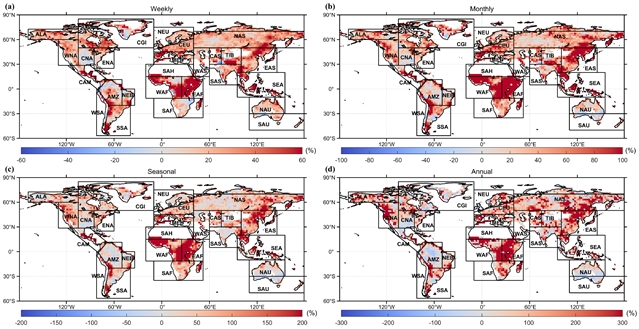
近日,北京师范大学郝增超团队报道了全球高温干旱在多个时间尺度上的增加。2025年9月24日出版的《中国科学:地球科学》杂志发表了这项成果。
高温干旱是指同时发生或连续发生的极端高温和干旱,它们对自然系统和人类社会的影响比单独发生时更大。热干旱变率研究一般只关注与之相关的特定时间尺度,缺乏对其跨时间尺度变化的全面认识。
研究组基于ECMWM第五代再分析数据(ERA5)分析了历史时期(1951–2014)全球多时间尺度干热事件变化,并基于第六次国际耦合模式比较计划(CMIP6)模拟数据预测了未来气候情景(2015–2100)。结果显示,历史时期内周、月、季、年尺度的干热事件发生频率显著增加(相对变化率分别为31.73%、65.15%、92.27%和184.63%)。同时,四个时间尺度的干热事件空间范围也呈现一致扩大趋势(每十年增长率分别为1.16%、1.84%、2.26%和3.38%)。
这些变化可归因于人类活动影响。在选取的26个气候区中,东非、东亚、南欧/地中海、撒哈拉、东南亚和西非在历史时期多个时间尺度上表现出更显著的频率或空间范围增幅。在SSP2-4.5情景下,未来时期亚马逊、地中海、巴西东北部、南部非洲、澳大利亚南部/新西兰和南美西海岸等区域预计将出现跨多时间尺度的干热事件频率与空间范围加剧,其中多个尺度呈现显著增长。该研究结论可为制定适应战略提供参考,以应对未来变暖背景下跨时间尺度的极端事件威胁。
附:英文原文
Title: Increases in global hot droughts across multiple timescales
Author: Yitong ZHANG, Zengchao HAO, Yang CHEN, Yuting PANG, Vijay P. SINGH
Issue&Volume: 2025/09/24
Abstract: Hot droughts are concurrent or consecutive hot extremes and droughts that can cause larger impacts on natural systems and human society than each occurring alone. Research of hot drought variability generally paid attention to a specific timescale relevant to impacts therein, leaving a comprehensive understanding of changes across timescales lacking. We investigated changes in global hot droughts at multiple timescales in historical periods (1951–2014) based on ECMWF Reanalysis v5 (ERA5) and future climates (2015–2100) based on simulations from the Coupled Model Intercomparison Project Phase 6 (CMIP6). An increase in the frequency of hot droughts for weekly, monthly, seasonal, and annual scales (with relative changes of 31.73%, 65.15%, 92.27%, and 184.63%, respectively) was observed in historical periods. In addition, we found a consistent increase in the spatial extent of hot droughts for the four timescales (with trends of 1.16%/decade, 1.84%/decade, 2.26% decade, and 3.38%/decade, respectively) in historical periods. These increases in the frequency and spatial extent of hot droughts can be attributed to anthropogenic influences. For the selected 26 climate regions, Eastern Africa (EAF), Eastern Asia (EAS), Southern Europe/the Mediterranean (MED), Sahara (SAH), Southeast Asia (SEA), and Western Africa (WAF) showed higher increases in the frequency or spatial extent for multiple timescales during the historical period. Increased frequency and spatial extents of hot droughts were projected under the Shared Socioeconomic Pathway (SSP) 2–4.5 scenario in the future period, with prominent increases in Amazon (AMZ), MED, Northeast Brazil (NEB), Southern Africa (SAF), Southern Australia/New Zealand (SAU), and West Coast South America (WSA) across multiple timescales. The findings can be useful for developing adaptation strategies to cope with threats from extremes across timescales in a warmer future.
DOI: 10.1007/s11430-024-1680-4
Source: https://www.sciengine.com/SCES/doi/10.1007/s11430-024-1680-4
Science China Earth Sciences:《中国科学:地球科学》,创刊于1952年。隶属于施普林格·自然出版集团,最新IF:5.7
官方网址:https://www.sciengine.com/SCES/home
投稿链接:https://mc03.manuscriptcentral.com/sces
